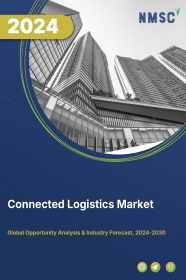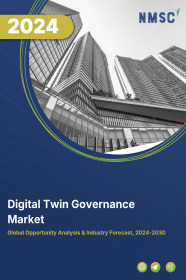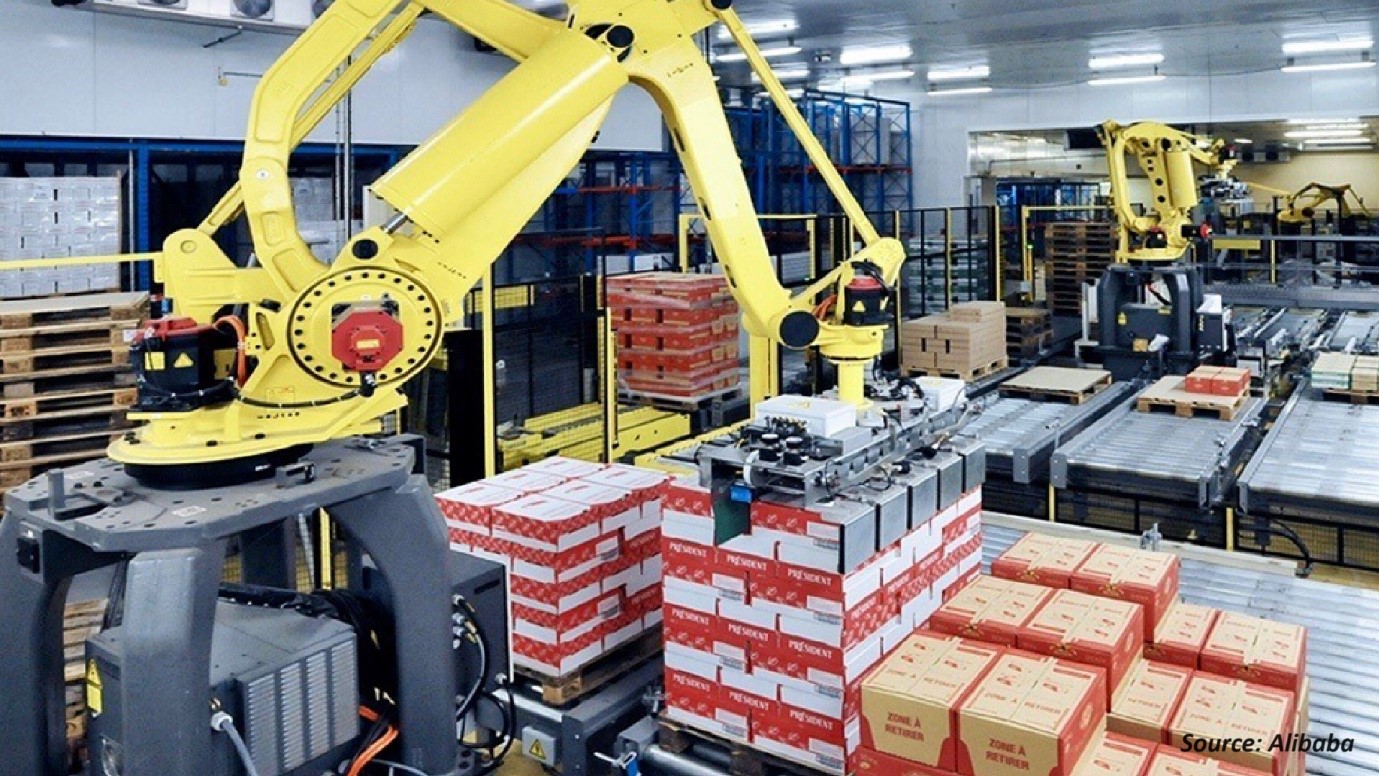
Connected Logistics Market by Component (Hardware, Software, and Services), by Technology (Bluetooth, Cellular, Wi-Fi, ZigBee, NFC, and Satellite), by Devices (Gateways, RFID Tags, and Sensor Nodes), and by Transportation Mode (Roadways, Railways, Airways, and Waterways) - Global Opportunity Analysis and Industry Forecast, 2023 – 2030
Industry: ICT & Media | Publish Date: 27-Nov-2024 | No of Pages: 226 | No. of Tables: 124 | No. of Figures: 94 | Format: PDF | Report Code : IC56
Market Definition
At an estimated value of over USD 23.77 billion in 2022, the Global Connected Logistics Market is predicted to thrive at a CAGR of 14.86% from 2023 to 2030 and to reach USD 71.94 billion by 2030.
Connected logistics, also known as smart logistics refer to a set of hardware and software that enables real-time access, track shipments, enhanced productivity and efficiency through the use of various integrated platforms. Connected logistics integrate multiple devices into single operational platform to enable informed decision-making regarding the logistical processes. Connected logistics service providers have developed various solutions including Electronic Data Interchange (EDI), Transport Management Systems (TMS), and others for ease of accessibility and extensive interoperability. These solutions offer interconnected services from both ends that help in easing the entire operational process.
Market Dynamics and Trends
The increasing demand for e-commerce with the boost in global trade has led to a growing need for real-time monitoring and visibility of the logistics and supply chain. This pushed companies to use connected logistics solutions to optimize their supply chain operations and provide real-time tracking and monitoring of goods in transit. The benefits of connected logistics solutions include improved efficiency, reduced risk of lost or damaged goods, and the ability to meet customer demands for faster and more reliable delivery. As a result, it is expected to drive the growth of the connected logistics market.
Moreover, the integration of advanced technologies, such as the Internet of Things (IoT), cloud computing, and big data analytics have made it possible to collect, process, and analyze vast amounts of data from logistical operations. This has enabled the development of connected logistics solutions that can provide actionable insights and improve operational efficiency in the smart logistics industry.
Furthermore, technological advancements, such as IoT, cloud computing, AI, ML, and blockchain, which enable real-time tracking of logistics are further driving the growth of the market.
However, the initial capital expenditure including hardware & software, and ongoing maintenance costs associated with connected logistics that involve costs related to software updates, hardware repairs or replacements can pose a challenge to widespread adoption, which is expected to restrain the growth of the connected logistics industry.
On the other hand, an increase in the number of high-tech vehicles equipped with GPS systems and telematics devices, allows logistics companies to track shipments, monitor vehicle locations, and obtain accurate delivery status updates. These improve tracking and visibility and enable better supply chain management, optimized route planning, and more precise estimations of delivery times, which is thereby expected to create ample opportunity for the growth of the smart logistics market.
Market Segmentations and Scope of the Study
The global connected logistics market share is segmented on the basis of component, technology, devices, transportation mode, and geography. On the basis of component, the market is divided into hardware, software, and services. Software is further sub-segmented on the basis of asset management, warehouse IoT, security network management, and streaming analytics. On the basis of technology, the market is segmented into Bluetooth, cellular, Wi-Fi, Zigbee, NFC, and satellite. On the basis of devices, the market is classified into gateways, RFID tags, and sensor nodes. On the basis of transportation mode, the market is segmented into roadways, railways, airways, and waterways. Geographic fragmentation and analysis of each segment includes regions comprising North America, Europe, Asia Pacific, and RoW.
Geographical Analysis
North America holds the major share of connected logistics market and is expected to continue its dominance during the forecast period. The growing e-commerce sector driven by the surge in online shopping and consumer demand for efficient deliveries are driving the growth of the connected logistics market in this region. According to the U.S. Department of Commerce, the e-commerce industry recorded sales of USD 1,040 billion in 2022. This significant figure underscores the large scale and continuous growth of the e-commerce sector therefore boosting the adoption of smart logistics.
Also, the presence of e-commerce giants, such as Amazon and Walmart are increasingly adopting connected logistics solutions such as real-time tracking, monitoring systems, and transportation management systems. These solutions help logistics companies to manage their operations more efficiently, optimize their routes, and reduce delivery times, thereby improving the overall customer experience. As a result, boosting the growth of the smart logistics market in the region. For instance, in November 2022, Amazon announced AWS Supply Chain, an application aimed at enhancing supply chain visibility for businesses by automatically integrating and analyzing data from various supply chain systems. The application intends to help companies make faster and more informed decisions, reduce costs, mitigate risks, and improve customer experiences.
On the other hand, Asia-Pacific is expected to show a steady rise in the smart logistics market owing to the growing e-commerce industry in China, India, and Japan driven by the need for efficient supply chain operations, optimized last-mile delivery, and effective inventory management. According to the International Trade Administration, the significant growth of China's e-commerce market which is projected to reach USD 3.56 trillion by 2024, will have a profound impact on the connected logistics industry.
Moreover, the presence of one of the world’s largest railway networks in countries such as India, China, and Japan coupled with the adoption of real-time tracking systems, automated inventory management, and predictive analytics revolutionized logistics operations, further boosting the demand for smart logistics services in the region. According to the National Investment Promotion & Facilitation Agency, Indian railways operate 9,146 freight trains daily and achieved a record in freight loading of 1512 MT in FY 22-23.
Competitive Landscape
Maximum growth opportunities make the connected logistics market highly competitive. Some of the major players in the market are SAP SE, Thingworx, AT&T Inc., SecureRF, Cisco Systems Inc., Zebra Technologies, IBM Corporation, GT Nexus, Eurotech S.P.A., Oracle Corporation, Intel Corporation, Infosys Limited, HCL Technologies Limited, Orbcomm Inc, and Freightgate Inc. A number of developmental strategies have been adopted by these companies in the past few years.
For instance, in February 2022, Logistics provider C.H. Robinson and autonomous technology leader Waymo Via partnered to advance autonomous trucking in supply chains. The collaboration aims to improve efficiency and safety by integrating Waymo Via's autonomous driving systems. This partnership signifies a significant step forward in adopting autonomous technology in logistics.
Also, in September 2020, SAP SE announced the launch of the SAP Logistics Business Network. The latest version of the cloud-based logistics network platform aims to enable companies to manage logistics transactions with their customers, suppliers, and logistics partners more efficiently.
Key Benefits
-
The connected logistics market report provides a quantitative analysis of the current market and estimations through 2023-2030 that assists in identifying the prevailing market opportunities to capitalize on.
-
The study comprises an extensive analysis of the market trend including the current and future trends for depicting the prevalent investment pockets in the market
-
The information related to key drivers, restraints, and opportunities and their impact on the market is provided in the report.
-
The market share of the players in the global connected logistics market along with their competitive analysis.
-
Value chain analysis in the market study provides a clear picture of the stakeholders’ roles.
Key Market Segments
By Component
-
Hardware
- Software
-
Asset Management
-
Warehouse IoT
-
Security Network Management
-
Streaming Analytics
-
-
Services
By Technology
-
Bluetooth
-
Cellular
-
Wi-Fi
-
ZigBee
-
NFC
-
Satellite
By Devices
-
Gateways
-
RFID Tags
-
Sensor Nodes
By Transportation Mode
-
Roadways
-
Railways
-
Airways
-
Waterways
By Geography
-
North America
-
U.S.
-
Canada
-
Mexico
-
-
Europe
-
U.K.
-
Germany
-
France
-
Italy
-
Spain
-
Denmark
-
Netherlands
-
Finland
-
Sweden
-
Norway
-
Russia
-
Rest of Europe
-
-
Asia-Pacific
-
China
-
Japan
-
India
-
South Korea
-
Australia
-
Indonesia
-
Singapore
-
Taiwan
-
Thailand
-
Rest of Asia-Pacific
-
-
RoW
-
Latin America
-
Middle East
-
Africa
-
Key Players:
-
SAP SE
-
Thingworx
-
AT&T Inc.
-
SecureRF
-
Cisco Systems Inc.
-
Zebra Technologies
-
IBM Corporation
-
GT Nexus
-
Eurotech S.P.A.
-
Oracle Corporation
-
Intel Corporation
-
Infosys Limited
-
HCL Technologies Limited
-
Orbcomm Inc
-
Freightgate Inc
REPORT SCOPE AND SEGMENTATION:
|
Parameters |
Details |
|
Analysis Period |
2022–2030 |
|
Base Year Considered |
2022 |
|
Forecast Period |
2023–2030 |
|
Market Size Estimation |
Billion (USD) |
|
Market Segmentation |
By Component (Hardware, Software, and Services), by Technology (Bluetooth, Cellular, Wi-Fi, ZigBee, NFC, and Satellite), by Devices (Gateways, RFID Tags, and Sensor Nodes), and by Transportation Mode (Roadways, Railways, Airways, and Waterways) |
|
Geographical Segmentation |
North America (U.S., Canada, Mexico) Europe (U.K.,Germany, France, Italy, Spain, Denmark, Netherlands, Finland, Sweden, Norway, Russia), Asia-Pacific (China, Japan, India, South Korea, Australia, Indonesia, Singapore, Taiwan, Thailand, Rest of Asia-Pacific), Rest of the World (Latin America, Middle East, Africa) |
|
Companies Profiled |
SAP SE, Thingworx, AT&T Inc., SecureRF, Cisco Systems Inc., Zebra Technologies, IBM Corporation, GT Nexus, Eurotech S.P.A., Oracle Corporation, Intel Corporation, Infosys Limited, HCL Technologies Limited, Orbcomm Inc, Freightgate Inc |

















 Speak to Our Analyst
Speak to Our Analyst





















